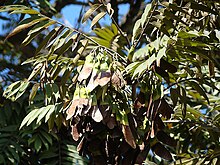| Machaerium villosum | |
|---|---|

| |
| Conservation status | |
 Vulnerable (IUCN 2.3) | |
| Scientific classification | |
| Kingdom: | Plantae |
| Clade: | Tracheophytes |
| Clade: | Angiosperms |
| Clade: | Eudicots |
| Clade: | Rosids |
| Order: | Fabales |
| Family: | Fabaceae |
| Subfamily: | Faboideae |
| Genus: | Machaerium |
| Species: | M. villosum |
| Binomial name | |
| Machaerium villosum Vogel | |
Machaerium villosum, the jacarandá-do-cerrado, jacarandá-pardo, jacarandá-paulista, or jacarandá-pedra, is a native tree belonging to the Fabaceae family, primarily in Brazil. These trees preferably grown on the Cerrado and Caatinga, but they can also inhabit the Atlantic Forest. They are currently vulnerable due to logging and, primarily, habitat loss for agriculture and livestock.
Characteristics
Flowers and fruits
The jacarandás-paulista have panicle-type inflorescences, composed of white flowers with a green and white striped banner, that emits a sweet scent to attract its pollinators. This plant produces samara-type fruits, typically dispersed by the wind.
Flowering usually occurs from August to January, peaking between October and December, while fruiting is observed throughout the year, mainly between January and June. Flowers and fruits can be found in January, March, and October.
Wood
This tree can provide hardwood very similar to that of jacarandá-da-bahia (Dalbergia nigra). Its surface is irregularly shiny, with a brown trunk featuring reflections, stripes, or dark shadows. It is widely used in the manufacture of luxury furniture, decorative items, parquet, and flooring.
References
- World Conservation Monitoring Centre (1998). "Machaerium villosum". IUCN Red List of Threatened Species. 1998: e.T32980A9740468. doi:10.2305/IUCN.UK.1998.RLTS.T32980A9740468.en. Retrieved 17 November 2021.
- IUCN (1998-01-01). Machaerium villosum: World Conservation Monitoring Centre: The IUCN Red List of Threatened Species 1998: e.T32980A9740468 (Report). International Union for Conservation of Nature. doi:10.2305/iucn.uk.1998.rlts.t32980a9740468.en.
- ^ "Flora e Funga do Brasil". floradobrasil.jbrj.gov.br. Retrieved 2023-11-20.
- "Madeira de Lei". www.esalq.usp.br. Retrieved 2023-11-20.
This Dalbergieae-related article is a stub. You can help Misplaced Pages by expanding it. |